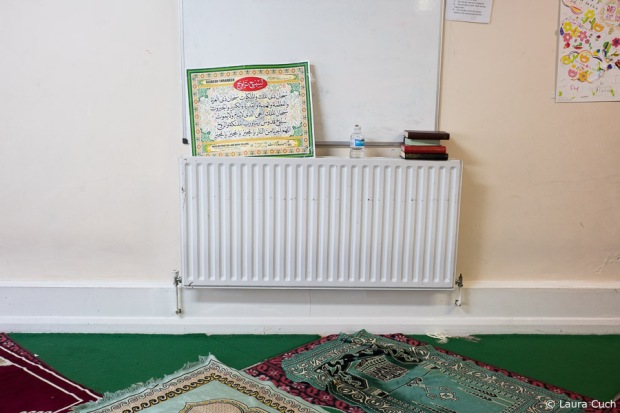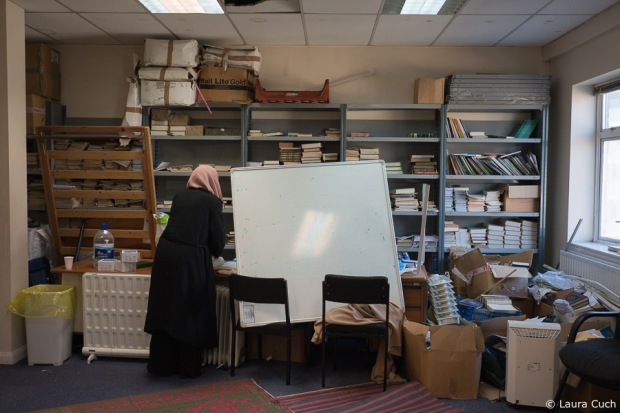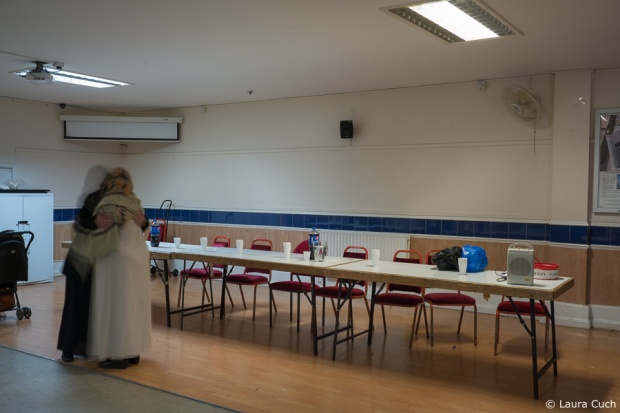Text by Dr. Nazneen Ahmed
Photographs by Laura Cuch
Between May and August this year, one of our key case studies, the West London Islamic Centre, held a series of farewell events to mark the impending demolition and redevelopment project. These included a “Communitea” for the broader Ealing community, the annual WLIC Family Fun Day, a final Friday prayers, and then, finally, a meal for worshippers with moving speeches broadcast throughout the mosque the night before it finally closed on Monday 7th August and demolition work began.
The mosque and community centre has been a space in which Laura and I have spent a considerable amount of time over the course of the project. We’ve attended three Eid fun days, many classes, lunches and activities organised by the very busy groups at the mosque. The redevelopment project marks a major moment of transition for this mosque. For us as researchers into sacred space in Ealing, it has been both important to record the feelings and reflections of the mosque’s worshippers at this time, as well as the building itself, which will soon be rubble. As we’ve talked to people and Laura’s taken her extraordinary photographs, the humble warehouse building has gradually transformed for us. We see and experience it quite differently now, to how we did when we first huddled in the beige hall for the first lecture in Urdu we attended in January 2015.
The WLIC follows a familiar historical pattern to other large urban mosque communities in England. In the 1980s, Muslims in Ealing gathered in local homes for Friday prayers and Quran classes. In 1984 these worshippers raised enough funds to purchase two houses on Oaklands Road, which were knocked together to make what has now become known as a “house mosque.” By the early 1990s, however, this was far too small and the mosque’s committee searched for new premises. They ended up purchasing a warehouse which had been used for, amongst other things, a location for an episode of Dr Who in the 1970s. One of our interviewees recalled the purchase. He remembered someone in the community scoffing at the size of the property. “How will we fill this?” he wondered. Twenty five years later, on Fridays, the congregation now spills out into the car park because this warehouse is now too small.
This ramshackle warehouse building was transformed into a mosque through considerable work and effort. But the focus was very much on making a usable building, not a beautiful one. In a poem I’m working on called “this is the house god built”, I describe the WLIC building as a series of “overfilled cardboard boxes stacked on top of each other.” It has the feel of something put together hastily, expanded and added to in an ad hoc fashion. The carpet in the sister’s section is a lurid purple and green while the minbar is blue and white, and the floor in the halls a peeling, beige linoleum.
Yet it is beautiful. It has accrued sacredness through prayer and through the love of the community for whom it has been, as it was frequently, almost obsessively described in conversation, a “second home.” One of the many migrant and refugee women who come to this mosque used the sisters’ space as a place to sleep because she lives in a hostel that’s very loud at night, and she knew her children would be safe playing in the tranquil prayer space while she did so, with other women nearby to watch them. Others found within it an alternative to the family support left behind elsewhere. Not for nothing does every woman at this mosque call each other sister, each man call the other brother.
This sense of community seems to have seeped the very walls of the building, little by little, through every act of doing, every gesture of kindness and love that has been performed within it. Each event which raised money for charitable causes, including Macmillan Cancer Relief, where women came together, bringing massive vats of biryani and cakes which could have made the final of the Great British Bake Off. Every Thursday class with Sister Mariam in which she simultaneously gave a dazzling exposition of the Qu’ran and set the world, families and marriages to right, and made everyone laugh and be better too. Every time a brother without family used the mosque as a place to stay and the uncles fed him. All of these and more have, over time, changed the way this once cold, echoing warehouse felt and looked. It has been remade.
I don’t think it would have been possible to really celebrate this special nature of this building without Laura Cuch’s photographs. Somehow, she manages to capture the numinous qualities of this building by focusing our attention on its details. Her photographs freeze the building (now rubble) in time, hushing its almost ever present sounds so we can appreciate the way the light filtered through its windows, the delicate tile work of the minbar. But there’s also something else, which I just can’t put my finger on, in these photographs. It’s the quality of a building that has been well loved, appreciated, cared for, worshipped in, laughed in, wept in, for years and years. Laura’s photographs really bring the beauty of this most ordinary – and extraordinary – space to light.
At the recent Muslims in Britain Research Network conference on British Muslim creativity, I presented a paper on Laura’s photographs and the special atmosphere of the sisters’ space. The piece I presented was a personal reflective essay on the space, because the mosque means more to me than simply a site of ethnographic field work.
Both Laura and I felt very emotional at WLIC when we attended the final Eid prayers at the site before demolition. On Eid ul Fitr this month I took a photograph of the green and plum carpet, with its arched little musallah shapes. It’s the carpet I’ve touched my head to most in sujood, in a building that has also brought me closer to my faith. As researchers we are expected to remain neutral observers of our field sites, but this is always muddied through engagement and participation wherever you work. When you share the faith of those you are working with, it becomes even more complicated, so that, in Riyaz Timol’s words, you’re always “walking an ethnographic tightrope” between observation and participation. I’ve prayed with and shared three Ramadans with sisters at the mosque, I follow the Whatsapp group and when I visit it is to hugs from women who call me sister, and uncles who put their hands on my head and call me daughter. To some extent, it has become my mosque, my family, too.
So the farewell events we have been recording have also been farewells for us too, to a building and a community we have become close to, and who will now temporarily disperse, to pray at home, in halls, in other mosques nearby, to come together again in the same place, but a very different space, in perhaps another year or so. Insha’Allah.











You must be logged in to post a comment.